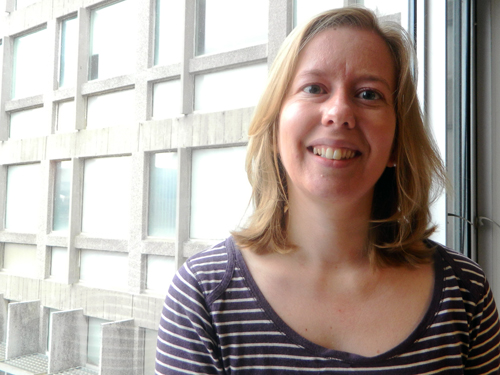
Married women in medieval Scotland weren’t supposed to have a voice. The law said that legally they were subject to and under the governance of their husbands.
So you might assume they wouldn’t appear frequently in court.
You’d be wrong. History post-doc Cathryn Spence has been studying the Scottish burgh records (essentially town records) from 1560 to the mid-1600s with a focus on court cases involving debt and credit. She found that about one-third of the cases involved married women, sometimes with their husbands, but sometimes on their own.
“I think that shows us that at any time in history, people’s lives are not as cut and dried as the laws might suggest,” says Spence. “Life is a bit more complicated.”
Spence’s research also took her to the wills and testaments filed at that time and a tax roll that lists every landlord and tenant in Edinburgh in 1635, street by street. She has transcribed that tax roll, and the resulting book will be published in October. “I’m quite excited about that,” she says.
The time period she studies marks the very beginning of capitalism in Scotland. “These records give us some ideas about how people interacted,” she says. The court cases were about loans or items that were sold on credit and not repaid.
Many of the cases involved servants. Besides their regular duties, servants would sometimes sell cups of beer, wine or ale on the streets. Sometimes this was done on behalf of their employers, but in other cases the servants bought the wine or other alcohol from their employers on credit. The servants would pay their bosses back once all the wine was sold and presumably make a profit.
However, those drinks were often sold on credit, too. Spence sometimes found cases where a servant would sue six or more people for the cost of a cup of beer. Another case involved a servant’s employer who took him to court for the cost of a large quantity of beer. She adds that the practice of selling alcohol by the cup on city streets was quite common at the time, not just in Scotland but in England as well.
That first study focused primarily on women, but she is now looking more broadly at men, women and families. While that data is still being analyzed, Spence says she’s found that marital status seems to matter as much for men as it does for women – it significantly improved their status in the community. The reason, she says, is because having a wife boosted the man’s economic stability. “We know that many wives worked alongside their husbands,” she adds. “The more people you have in your family, the better off you are economically.”
Spence is also intrigued by some of the regional differences she found. In the town of Dundee, for example, about 25 per cent of the women involved in the cases were not identified as married or widowed. This is a much higher percentage than in other towns in the area. She says it’s impossible to tell whether these women were actually single, or whether it was simply more common in Dundee to not identify a woman’s marital status. “These differences from one town to another surprised me.”
She also found evidence of young, fatherless girls who worked off their debts by making lace. Typically, these girls would be brought into the homes of their employers and work until they had paid back the money owed. Spence says that sometimes these debts seemed to be their own and sometimes they seemed to be paying off debts owed by their mothers or deceased fathers. “This actually functioned as a kind of apprenticeship for the girls,” says Spence. “There were very few apprenticeships for girls at that time – apprentices were almost all boys – so this was ultimately beneficial to them.”
Spence’s post-doc ends later this year. Originally from New Brunswick, she did her undergraduate studies at King’s College in Halifax, earning a degree in journalism and history. She worked at a daily newspaper in Moncton and then did a “working holiday” in Scotland before coming to U of G to do her master’s. Spence was offered a scholarship to complete her PhD at the University of Edinburgh and taught there. She also taught at Dalhousie University in Halifax and at Keele University in Staffordshire, England, before returning to U of G.
“I am fascinated by what we can learn about people’s lives in the past,” she says. “They worked very hard, and life was often quite precarious.”